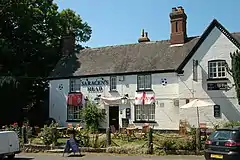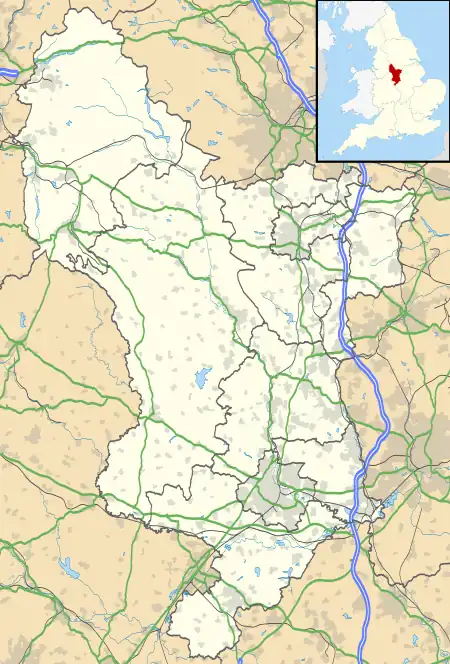Shirley, Derbyshire
Shirley is a small village and civil parish in Derbyshire, 4 miles (6 km) south-east of Ashbourne.[1] The population of the civil parish as taken at the 2011 Census was 270.[2] It is situated in the countryside on top of a small hill.
| Shirley | |
|---|---|
 The Saracen's Head, Shirley. | |
 Shirley Location within Derbyshire | |
| OS grid reference | SK218415 |
| District | |
| Shire county | |
| Region | |
| Country | England |
| Sovereign state | United Kingdom |
| Post town | ASHBOURNE |
| Postcode district | DE6 |
| Police | Derbyshire |
| Fire | Derbyshire |
| Ambulance | East Midlands |
History
Shirley was mentioned in the Domesday book as belonging to Henry de Ferrers[n 1] and being worth forty shillings.[3]
In the nineteenth century St Michael's Church, Shirley was led by the Rev. Charles Francis Powys who had a number of literary children.
Rev. Charles Francis Powys was the great nephew of Thomas Powys, created the first Lord Lilford in 1797, and the Powys' were also cousins of the Shirley family who held the living of the parish of Shirley in Derbyshire and were direct descendants of Earl Ferrers, the first Sheriff of the County.[4]
Notable residents
- John Cowper Powys, born in the town, "Derbyshire's most prolific author", according to Tom Bates[4]
- Theodore Francis Powys, born in the town, author[4]
- Gertrude Mary Powys, born in the town, painter[4]
- Littleton Charles Powys, author and headmaster of Sherborne School[4]
- Prof. Rev. Walter Waddington Shirley, historian at Oxford University
- Rev. William Richardson Linton, clergyman and botanist who wrote a Flora of Derbyshire and discovered Rubus durescens, a bramble endemic to Derbyshire
Notes
- Henry was given a large number of manors in Derbyshire including Doveridge, Linton, Brailsford and Cowley.
References
- AA Book of British Villages. Drive Publications Limited. 1980. p. 354. ISBN 9780340254875.
- "Civil Parish population 2011". Neighbourhood Statistics. Office for National Statistics. Retrieved 31 March 2016.
- Domesday Book: A Complete Translation. London: Penguin, 2003. ISBN 0-14-143994-7 p.746–7
- PeakDistrictOnline accessed 4 December 2007